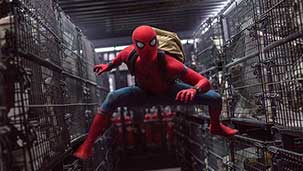On a many headed Hydra like Spiderman: Homecoming, everyone needs to be on the same page. These kinds of productions have countless departments involving hundreds of people and multiple locations across the globe.
That’s where you come in.
Concept artists make sure everyone has a firm grasp on the visual aesthetic underlying such a sprawling production. You illustrate and refine the costumes, architecture, technology—helping to create a consistent visual template for the film.
Spiderman: Homecoming is a success despite, or perhaps because of, the many hands involved in its creation (there are six separate screenwriting credits alone). It manages to artfully juggle everything it needs to—spectacularly well. From maintaining continuity within the MCU, dealing with the ghosts of iterations past and trying not to simply reproduce a formula while tweaking it enough to find something just a little bit different, it all works. But most importantly, from the costumes to the technology and all the small visual details, everything makes sense within the rules of this little pocket universe director Jon Watts and his umpteen producers have given birth to. It is a film that, while you are watching it, convinces you that every little widget and bauble belongs exactly where it rests.
The story is simple but effective. There is no long drawn out origin sequence, no exposition dumps. We find Peter Parker (Spiderman) already a semi Avenger juggling his profound responsibilities as a hero with the mundane agonies of a fifteen-year-old teenager. Tom Holland, who occupies the screen for almost the entirety of the film, was born to play this part.
Not surprisingly, the next best thing in Spiderman: Homecoming is Michael Keaton. He’s an actor who has seen a career as Batman, Birdman and now The Vulture; a gallery of heroes and villains that is novelistically serendipitous. Here he’s perfect as a blue collar guy who is criminally committed to maintaining a particular kind of economic status. He manages to infuse pathos into his character while still remaining completely menacing, and is easily the best MCU antagonist since Loki.
But it is his costume, a mechanized variant of a six-foot Vulture that steals the show. It is both menacing and grounded in a convincing ersatz reality. Each of his few appearances in the film are used to maximum effect and they assist in creating and sustaining a tension that ramps up all the way to a completely satisfying finish. This is a Marvel film with a solid third act.
The script, the casting, the humour, the visual storytelling, the overall tone—everything feels proper throughout. Usually there are at least two or three things that can pull you out of a film because they feel misaligned somehow, but that didn’t happen once with Spiderman: Homecoming.
Often the least convincing and impressive aspects of superhero films are, perversely, one of the things that make them what they are: the costumes. But here the design and execution is flawless. From Stark Technology to homemade duds (and even some peripheral moments involving some alien tech-weaponry) it all seems to fit just right.
Obviously there are a lot of people who deserve credit for that kind of seamless continuity, but it all starts with conceptual design and the person who makes it real. To take on board a disparate set of ideas and somehow make them flow into one reality—that we can all share—is why movies are, sometimes, a little bit magical.
Sincerely,

Tim







